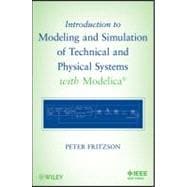
What is included with this book?
1. Basic Concepts 1
1.1 Systems and Experiments, 2
1.1.1 Natural and Artificial Systems, 3
1.1.2 Experiments, 5
1.2 The Model Concept, 6
1.3 Simulation, 7
1.3.1 Reasons for Simulation, 8
1.3.2 Dangers of Simulation, 9
1.4 Building Models, 10
1.5 Analyzing Models, 12
1.5.1 Sensitivity Analysis, 12
1.5.2 Model-Based Diagnosis, 13
1.5.3 Model Verification and Validation, 13
1.6 Kinds of Mathematical Models, 14
1.6.1 Kinds of Equations, 15
1.6.2 Dynamic Versus Static Models, 16
1.6.3 Continuous-Time Versus Discrete-Time Dynamic Models, 17
1.6.4 Quantitative Versus Qualitative Models, 18
1.7 Using Modeling and Simulation in Product Design, 19
1.8 Examples of System Models, 21
1.9 Summary, 27
1.10 Literature, 27
2. A Quick Tour of Modelica 29
2.1 Getting Started with Modelica, 30
2.1.1 Variables and Predefined Types, 35
2.1.2 Comments, 37
2.1.3 Constants, 38
2.1.4 Variability, 38
2.1.5 Default start Values, 39
2.2 Object-Oriented Mathematical Modeling, 39
2.3 Classes and Instances, 41
2.3.1 Creating Instances, 42
2.3.2 Initialization, 43
2.3.3 Specialized Classes, 44
2.3.4 Reuse of Classes by Modifications, 45
2.3.5 Built-in Classes and Attributes, 46
2.4 Inheritance, 47
2.5 Generic Classes, 48
2.5.1 Class Parameters as Instances, 48
2.5.2 Class Parameters as Types, 50
2.6 Equations, 51
2.6.1 Repetitive Equation Structures, 53
2.6.2 Partial Differential Equations, 54
2.7 Acausal Physical Modeling, 54
2.7.1 Physical Modeling Versus Block-Oriented Modeling, 55
2.8 The Modelica Software Component Model, 57
2.8.1 Components, 58
2.8.2 Connection Diagrams, 58
2.8.3 Connectors and Connector Classes, 60
2.8.4 Connections, 61
2.8.5 Implicit Connections with Inner/Outer, 62
2.8.6 Expandable Connectors for Information Buses, 63
2.8.7 Stream Connectors, 64
2.9 Partial Classes, 65
2.9.1 Reuse of Partial Classes, 66
2.10 Component Library Design and Use, 67
2.11 Example: Electrical Component Library, 67
2.11.1 Resistor, 68
2.11.2 Capacitor, 68
2.11.3 Inductor, 68
2.11.4 Voltage Source, 69
2.11.5 Ground, 70
2.12 Simple Circuit Model, 70
2.13 Arrays, 72
2.14 Algorithmic Constructs, 74
2.14.1 Algorithm Sections and Assignment Statements, 75
2.14.2 Statements, 76
2.14.3 Functions, 77
2.14.4 Operator Overloading and Complex Numbers, 79
2.14.5 External Functions, 81
2.14.6 Algorithms Viewed as Functions, 82
2.15 Discrete Event and Hybrid Modeling, 83
2.16 Packages, 87
2.17 Annotations, 89
2.18 Naming Conventions, 91
2.19 Modelica Standard Libraries, 91
2.20 Implementation and Execution of Modelica, 94
2.20.1 Hand Translation of the Simple Circuit Model, 96
2.20.2 Transformation to State Space Form, 98
2.20.3 Solution Method, 99
2.21 History, 103
2.22 Summary, 107
2.23 Literature, 108
2.24 Exercises, 110
3. Classes and Inheritance 113
3.1 Contract Between Class Designer and User, 113
3.2 A Class Example, 114
3.3 Variables, 115
3.3.1 Duplicate Variable Names, 116
3.3.2 Identical Variable Names and Type Names, 116
3.3.3 Initialization of Variables, 117
3.4 Behavior as Equations, 117
3.5 Access Control, 119
3.6 Simulating the Moon Landing Example, 120
3.7 Inheritance, 123
3.7.1 Inheritance of Equations, 124
3.7.2 Multiple Inheritance, 124
3.7.3 Processing Declaration Elements and Use Before Declare, 126
3.7.4 Declaration Order of extends Clauses, 127
3.7.5 The MoonLanding Example Using Inheritance, 128
3.8 Summary, 130
3.9 Literature, 130
4. System Modeling Methodology 131
4.1 Building System Models, 131
4.1.1 Deductive Modeling Versus Inductive Modeling, 132
4.1.2 Traditional Approach, 133
4.1.3 Object-Oriented Component-Based Approach, 134
4.1.4 Top-Down Versus Bottom-Up Modeling, 136
4.1.5 Simplification of Models, 136
4.2 Modeling a Tank System, 138
4.2.1 Using the Traditional Approach, 138
4.2.2 Using the Object-Oriented Component-Based Approach, 139
4.2.3 Tank System with a Continuous PI Controller, 141
4.2.4 Tank with Continuous PID Controller, 144
4.2.5 Two Tanks Connected Together, 147
4.3 Top-Down Modeling of a DC Motor from Predefined Components, 148
4.3.1 Defining the System, 149
4.3.2 Decomposing into Subsystems and Sketching Communication, 149
4.3.3 Modeling the Subsystems, 150
4.3.4 Modeling Parts in the Subsystems, 151
4.3.5 Defining the Interfaces and Connections, 153
4.4 Designing Interfaces–Connector Classes, 153
4.5 Summary, 155
4.6 Literature, 155
5. The Modelica Standard Library 157
5.1 Summary, 168
5.2 Literature, 168
A. Glossary 169
Literature, 174
B. OpenModelica and OMNotebook Commands 175
B.1 OMNotebook Interactive Electronic Book, 175
B.2 Common Commands and Small Examples, 178
B.3 Complete List of Commands, 179
B.4 OMShell and Dymola, 185
OMShell, 185
Dymola Scripting, 185
Literature, 186
C. Textual Modeling with OMNotebook and DrModelica 187
C.1 HelloWorld, 188
C.2 Try DrModelica with VanDerPol and DAEExample Models, 189
C.3 Simple Equation System, 189
C.4 Hybrid Modeling with BouncingBall, 189
C.5 Hybrid Modeling with Sample, 190
C.6 Functions and Algorithm Sections, 190
C.7 Adding a Connected Component to an Existing Circuit, 190
C.8 Detailed Modeling of an Electric Circuit, 191
C.8.1 Equations, 191
C.8.2 Implementation, 192
C.8.3 Putting the Circuit Together, 195
C.8.4 Simulation of the Circuit, 195
D. Graphical Modeling Exercises 197
D.1 Simple DC Motor, 197
D.2 DC Motor with Spring and Inertia, 198
D.3 DC Motor with Controller, 198
D.4 DC Motor as a Generator, 199
References 201
Index 207
The New copy of this book will include any supplemental materials advertised. Please check the title of the book to determine if it should include any access cards, study guides, lab manuals, CDs, etc.
The Used, Rental and eBook copies of this book are not guaranteed to include any supplemental materials. Typically, only the book itself is included. This is true even if the title states it includes any access cards, study guides, lab manuals, CDs, etc.